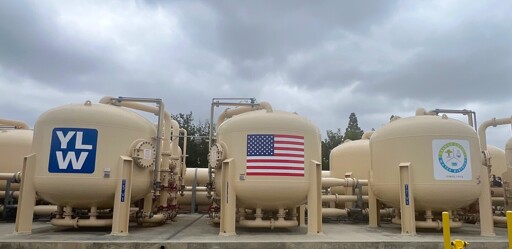Yorba Linda, then, is ahead of the game. The water district started worrying about addressing PFAS years before federal rules required it. When construction of the plant began in 2020, PFAS concentrations in some wells were two or three times higher than the level at which the state water board advised districts not to serve water. “We had a PFAS problem that we had to address,” says Mark Toy, the district’s general manager.
Inside the plant, 22 tanks stand quietly in two rows across the back of a parking lot, connected by pipes and valves. They are cream-colored and clean, decorated with American flags and logos for the city and county water districts. There are no jarring industrial sounds, no whirring parts, no smoke or steam. The plant doesn’t have the feel of infrastructure so complex and intimidating that it would be out of reach for a typical water district.
All 10 wells from which the water district draws its supply are close enough to the property for it to be treated at the same facility. Water drawn from the wells passes through vats in which positively charged resin beads act as magnets to attract negatively charged PFAS compounds. They remain stuck to the beads as the water moves on toward taps and showerheads.
Todd Colvin, Yorba Linda’s chief water systems operator, would like to see residents get past misconceptions about drinking tap water. “It’s better than the bottled water you buy,” he says. “We are doing great things.”
[photo caption] General manager Mark Toy holds samples of the resin used to capture PFAS. The dark resin has become saturated. When replaced, the saturated resin is incinerated at a permitted facility offsite. The high heat breaks down PFAS chemicals.
This is super cool :)
Hopefully we can start doing this everywhere.


